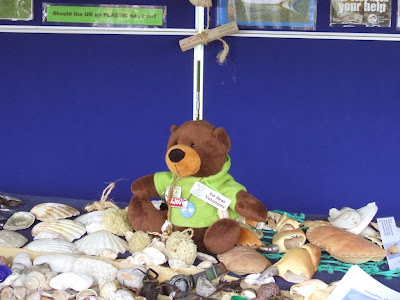I am here on Worthing Beach with my buddy Steve helping out at a beach clean event. As you know I have helped clean up beaches around the world and also seen many animals that have died from swallowing plastic or who have become entangled.
The event is part of the Marine Conservation Society annual beach clean when they encourage as many people as possible around the UK to clean their local beach and record all the litter they find. This is part of a very important survey that the Marine Conservation Society do each year to monitor if the litter problem is getting worst and what types of litter are found on the beach and when possible - where it comes from. you can find out more on the link below
http://www.mcsuk.org/beachwatch/
The beach event is organised locally by Transition Town a group who are making Worthing more sustainable in the way they do things and the way people live.
Lots of people turned up to sign up for the day
The nearby Fish Factory cooked a big paella of fresh sustainably caught sea food, so every one could have a free portion before they headed off to the beach.
Groups of people had a section of the beach to clean and monitor.
We saw some natural recyclers, carrion crows helping to clean the beach of dead animal remains when they scavenge for food.
And a little flock of wading birds called turnstones feeding on the waters edge.
They are called turnstones because they can flip pebbles and seaweed over with their beak to find tiny animals underneath that they feed on, such as sand hoppers.
We were also monitoring the ray and dogfish egg cases we found washed up. The egg cases are empty when they wash up on the beach. The shape is slightly different for various ray species.
This project is run by the Shark Trust and anyone can send in records of ray egg cases. You can find out more on the link below
http://www.sharktrust.org/en/great_eggcase_hunt/
This is a dogfish egg case, a type of cat shark that lives near the sea bed. We found many of these egg cases as well. A few larger shark species also visit Sussex water, including the blue shark, porbeagle shark and smoothhound. Earlier this year a basking shark, the second largest shark species, was seen off Brighton. The biggest sharks I have seen are great white sharks when visit shark experts Chris and Monique Fallows in South Africa last year. http://adventuresofedthebear.blogspot.co.uk/2012/11/ed-bear-comes-face-to-face-with-great.html
At the end of the beach clean, all the rubbish was weighed and the information about all the litter collected was sent to the Marine Conservation Society.
Tomorrow we are doing our beach clean on Shoreham Beach and also surveying the litter to send to the Marine Conservation Society.

























No comments:
Post a Comment